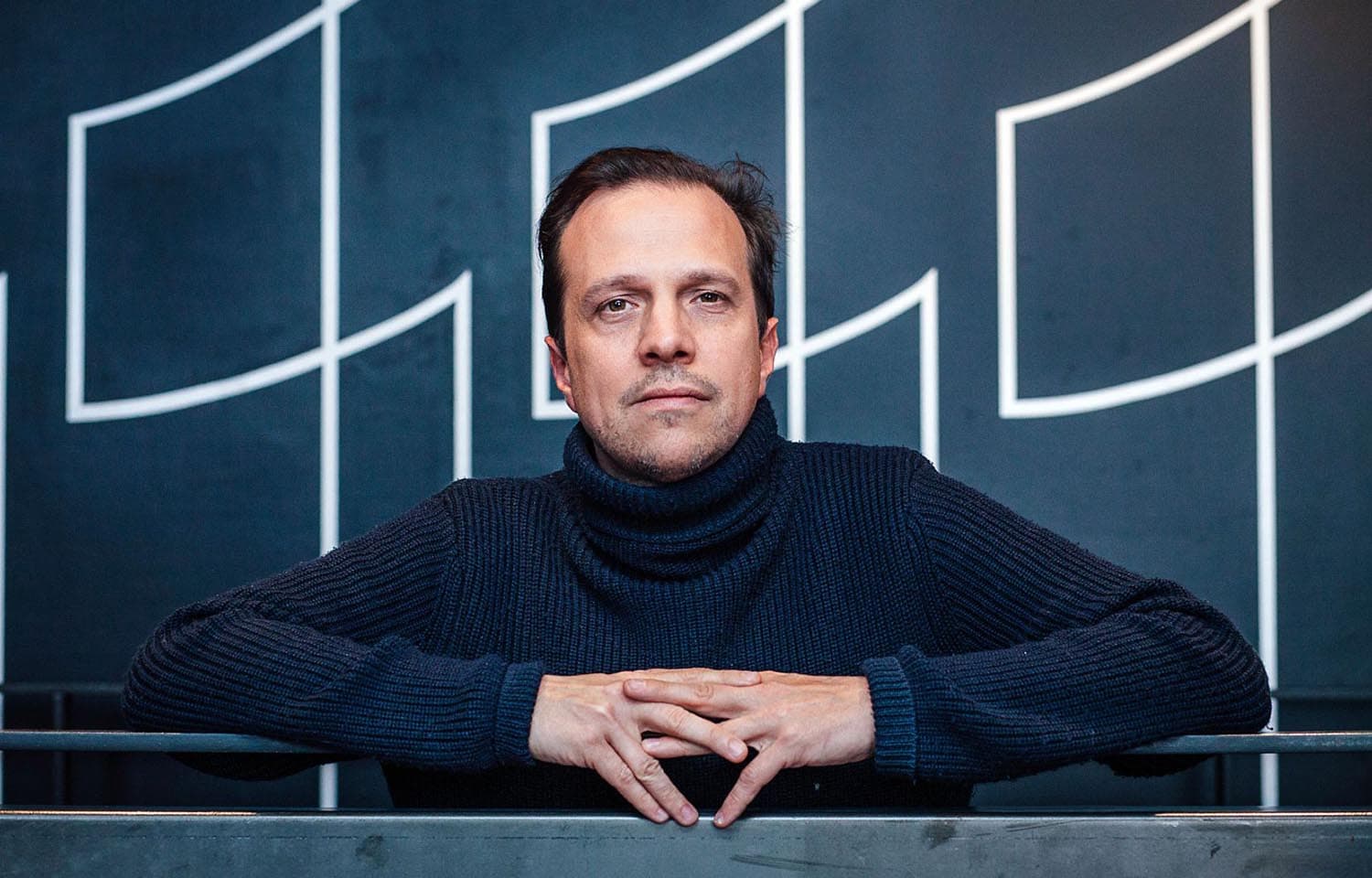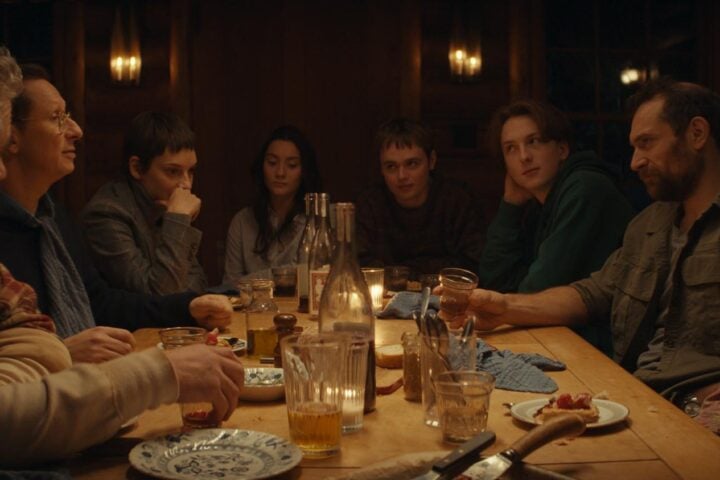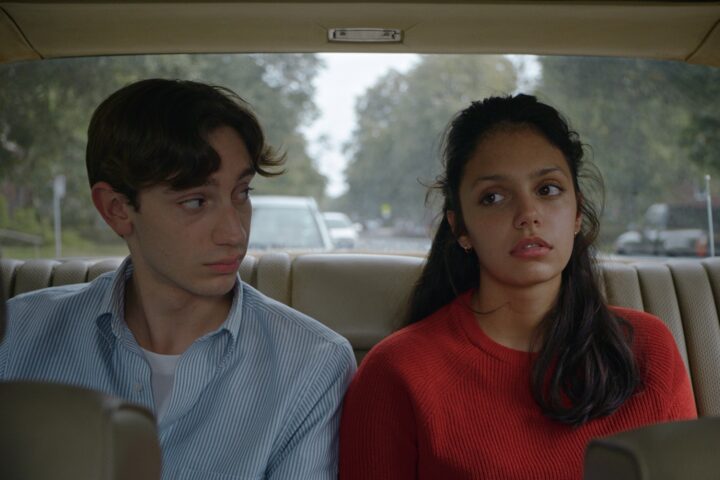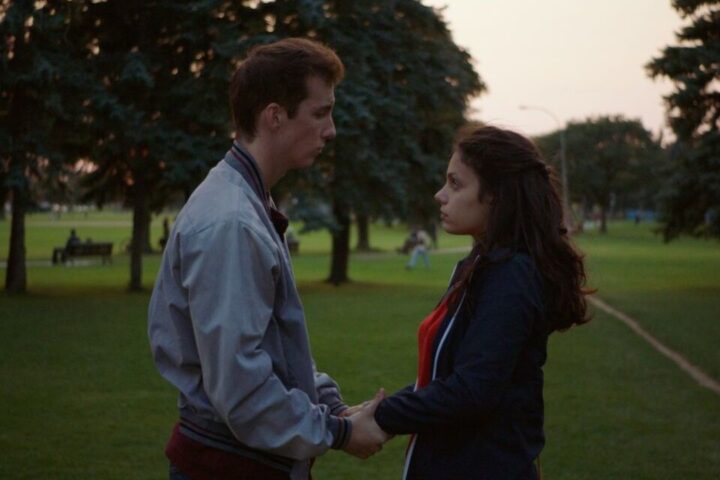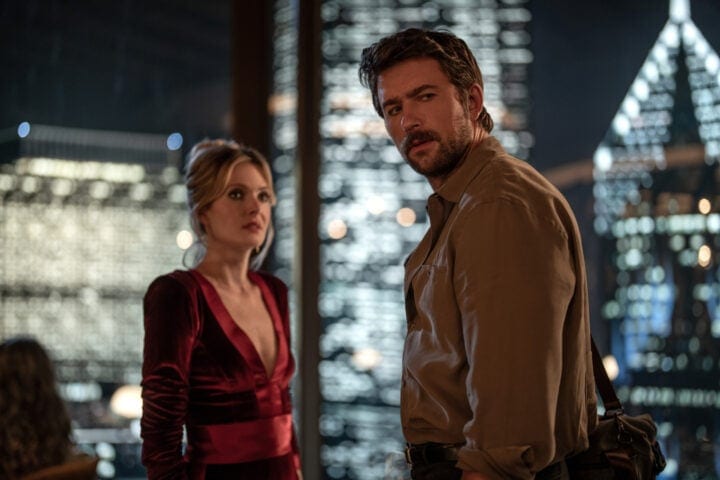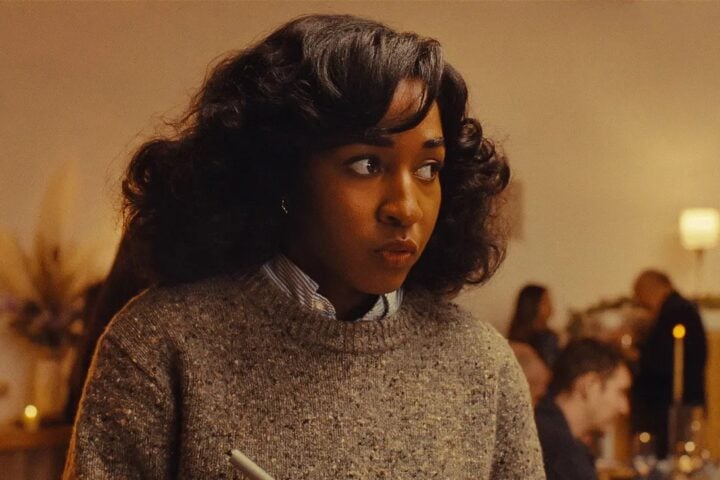Canadian director Philippe Lesage sits somewhere along the spectrum between François Truffaut and Richard Linklater when tracing the process of growing up. Since moving into narrative filmmaking with 2015’s The Demons, Lesage has pulled largely from the same group of young actors and followed their gradual progression from youth toward adulthood. The filmmaker tells me he plans to shoot a follow-up to 2018’s Genesis, following Théodore Pellerin’s Guillaume a decade after the film, but quips, “It’s not a sequel because I don’t expect that many people who have seen the previous films.”
Perhaps more audiences will come to discover Lesage’s filmography after seeing his latest work, Who by Fire. Four out of the film’s 10 actors return from previous collaborations with the director in this clash of generations that plays out in the secluded woods of rural Canada. Fault lines emerge across age, gender, status, professional attainment, and more as the middle-aged Albert (Paul Ahmarani), a screenwriter, heads for a reunion with his old collaborator Blake Cadieux (Arieh Worthalter) with three very volatile youths in tow.
In addition to Albert’s children, teenage Max (Antoine Marchand-Gagnon) and college-aged Aliocha (Aurélia Arandi-Longpré), he also arrives with his son’s best friend, Jeff (Noah Parker). This aspiring young filmmaker gets a crash course in the adage “don’t meet your heroes” when the 17-year-old develops an unexpected rivalry with their host. This volatile, vulnerable guest is hot-headed enough to provide the figurative flame that sets their tinderbox of insecurities on fire during the log cabin getaway. Lesage’s clear-eyed staging of the trip’s fallout makes for a coming-of-age drama with no upper age limit on who needs to mature.
I spoke with Lesage ahead of the American release of Who By Fire. Our talk covered how he thinks about the struggles faced by youth, why hands play such a prominent role in the film’s bookends, and what he changed about his directing style to exemplify his thematic message.
Since Who By Fire isn’t as autobiographical a project as your previous two films, who do you identify most with in the film: the young people or the adults?
The young people, obviously. I’m being very tough on the adults in the film, especially the men. There was an intention to deconstruct certain types of masculinity in the two main male adult characters. I think I wrote it because I wanted to make sure I’m not going to turn [into] them in some ways. When writing, there [are] things that I’m stealing from myself. There’s no escape. In fiction, I’m trying to be honest and sincere, and then I also go where it hurts. Which is, of course, your own flaws and shame. These are the most difficult things to talk about. I try to go there. There’s a reflection of me in all the characters, even the female characters. Young Aliocha with her ambition to write this book about the decline of the Western culture is actually the synopsis of a book I wrote in my 20s that I hope people will never find! [laughs]
You’ve noted that young people are different in front of adults. Are they purer or more themselves amongst their peers?
It’s not about being pure. There was a need for me to get out of the ambiance of teenage years and childhood that I was exploring in my earlier films. I wanted to confront those young people, who don’t have protection and come with good intentions and faith. They want to trust the adults and the future. It’s true in all my films, beyond the obstacles and the toxicity of society, I really hope that they will be able to grow old without fear and without trying to protect themselves too much. If you start to protect yourself too much, you become a bitter adult who’s afraid of following their passion or what makes themself special. Starting a relationship with somebody you’re in love with, it’s a risk because you can get hurt.
It’s the same [for other] things that have values in life, in my opinion. If I had remained completely anonymous as an obscure filmmaker—I’m not saying that I’m a famous filmmaker, but at least I’m able to make my films, which is such a privilege—there’s a risk there. I [hope] that they will be able to keep a pure heart in the sense of being able to go through life with generosity and without thinking, “Oh my God, I can get hurt there.” If you don’t trust people enough, you’re going to have a miserable life. I think that the reason why I’m writing about these young people facing tough situations, it’s maybe my own selfish reminder that I shouldn’t become this bitter adult who’s trying to protect himself like a wounded bird.
Do you think that you’ve grown up alongside the films, or is it just a coincidence that the progression of your work has featured increasingly older protagonists?
I need to have a certain distance [from what I write] since I put a lot of my guts into [it]. I’m not saying that everything is completely autobiographical, but I’m putting myself back in the shoes of a young adult. I need a certain [amount of] time to make it an interesting story. My situation as an adult now is that I’m a young new father. It’s going to be an interesting adventure to have this role and see this kid grow up, but I think I need another 10 years before I write about it.
You’ve noted that you were trying to have a better shooting experience with Who By Fire than you had with Genesis, which wasn’t enjoyable for you to film. What did you change here, and do you think that showed at all in the final product?
Since I was doing a film about toxic masculinity, I had to show the example by not falling into it! [laughs] I think we’re misguided when we assume that the director should be this over-confident captain. I [used to feel that] if I showed that I had doubts, my crew wasn’t going to follow me. But then I realized that it’s also a strength to accept that you can sometimes have a bad day and try not to panic if the moment comes when you don’t know where to place the camera. When I was more immature, I was like, “Oh my god, they’re gonna think that I don’t know what I want,” when there are 50 people waiting for you on set. That was my problem.
But it’s true that I don’t know what I want. I know what I don’t want, and that’s the starting point of everything. On that set, I could tell my actors as people that I trust and deal with my insecurities. ln trying to accept them and talking about them, they were no longer insecurities because I was admitting, “Okay, so now we need 20 minutes. You can leave the set.” We’d clear the set, and then without panic, I was working with my cinematographer Balthazar [Lab] and saying, “Okay, how are we going to shoot that scene now?” We got to take the time; there was no rush; there’s no more fear of looking like people who don’t know what they want.
On every film set, there’s going to be tension and people getting a bit upset, and that’s normal. But I don’t let anything rot. If I have an issue with somebody, or they have an issue with me, we need to sort it out as soon as possible. Then, the tension is released and people are happy. I have to give an example of what I’m expecting from the people I’ve worked with. I expect them to tell me also when they’re not happy. I expect them also to express their doubts and insecurities because, at the end of the day, the director is responsible for everything. He’s responsible for what is shot, the atmosphere on the film set, and the happiness of the crew.
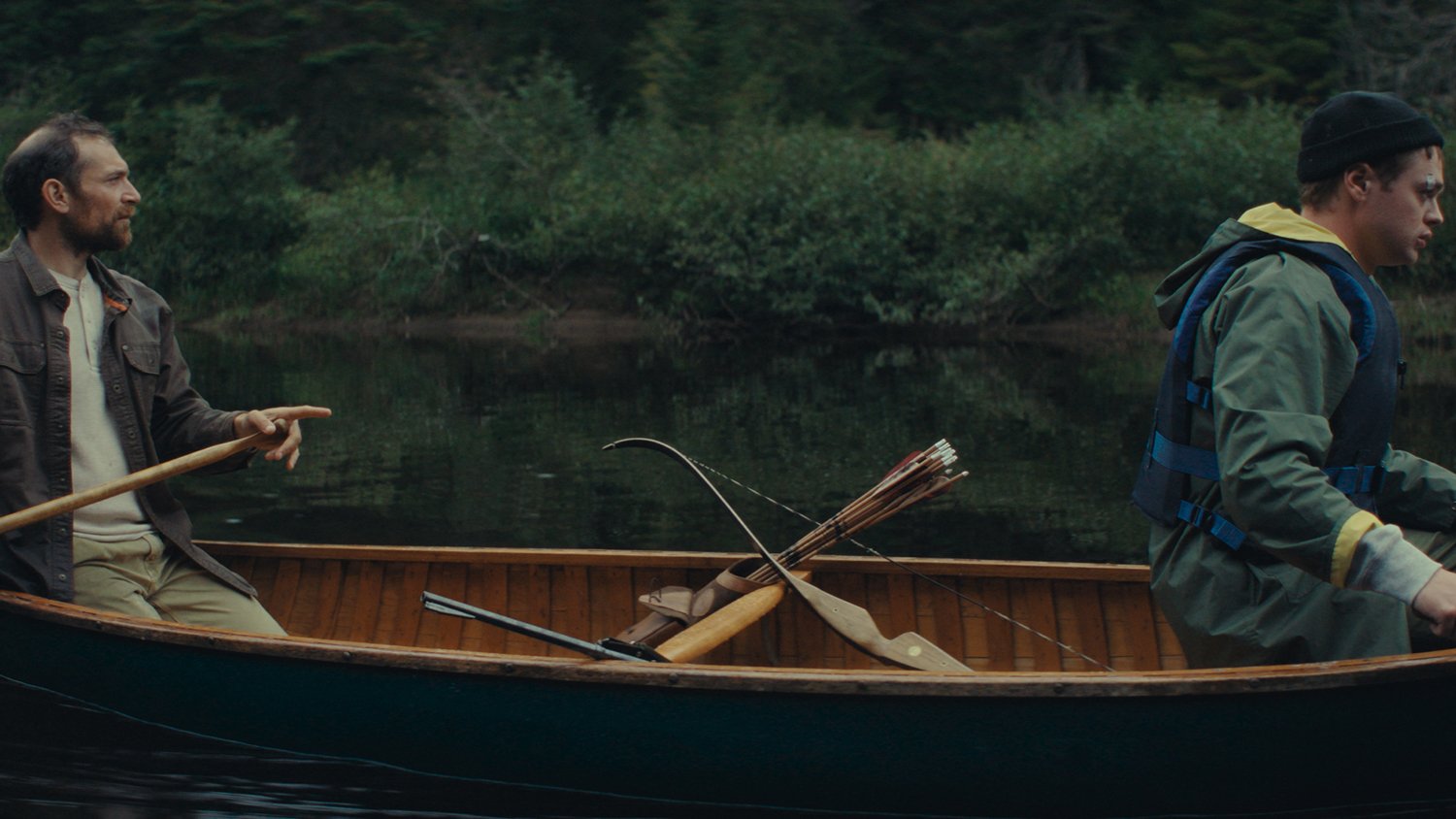
Is that part of why you saved shooting the dinner sequences for the end? These centerpiece sequences of the film are so dynamic, so did it help to sort out any insecurities around the language before staging them?
The first couple days of shooting, if you do two big scenes of acting even with a lot of dialogue, it always ends up in the garbage bin. Since it’s an expensive art form, you need to be careful about what you shoot during the first couple of days. I shot the car scenes and the landscape in the first couple of days, and that was a good idea. The same thing goes for the “main dishes” of the film, which are the dinner scenes. When there’s a week left on a long shoot like this, people are happy and excited. They also feel the end coming, so there’s a renewal of energy. Maybe there’s fatigue and tiredness at some point close to the end, but not in the last week.
Everybody knew where they were in their characters, knew each other, knew how I work, so we didn’t struggle to make those scenes. It was so fluid and natural, so I had the luxury to say, “Okay, now we have a very intense one in terms of tension. Now, let’s do one more subtle. Now we have the subtle one, so you can even try to get out more of the dialogue in the scene.” We were exploring with pleasure but also complete concentration because we knew that these were the important scenes. Shooting them at the end was the best idea I had in terms of schedule.
Your previous two films feature songs fairly heavily, whereas the score is a larger part of the sonic atmosphere in Who By Fire. What motivated this shift? Do you see the music as serving a similar function?
In Genesis, I was hitting like with a hammer three or four times on the same song, the Tops’s “Outside.” For me, it was absolutely fitting the teenage mood because we all have listened to a song we like obsessively on repeat. When you’re young and think about love aches, it’s like putting a little bit of salt on your wound with masochistic pleasure. Here, I’m using music more intra-diegetically, where it’s playing in the film and the characters are listening to it. For the “Rock Lobster” scene, I really wanted to make a memorable, powerful dancing scene. There are so many in Canadian films over the last 10 years, so I really wanted to nail it. We knew we were doing it while shooting because the crew and everybody was like, “Oh my god, something magical is happening.” I have a huge playlist when I write, and I know that a couple of songs that I listen to will end up in the film. The ones that I get the rights for!
Hands are in the opening shot and feature on the poster. Why are they so important to you on this project?
It’s a hidden homage to the opening of A Man Escaped. We see those hands like this [holds out hands], and then we discover that he’s wearing handcuffs. Here, it’s the same gesture, but it’s just a teenager before he approaches his hand towards Aliocha. He’s just looking if his nails and hands are clean. I thought it was just so nice to start the film on hands and end the film on hands with Aliocha caressing a poem anthology by Emily Dickinson. But Robert Bresson is the master of filming human hands, and he does it in an almost mystical way that I love.
There’s a challenge of defining masculinity in a positive light that isn’t just emulating the traits we like in women. Is there a version of positive masculinity we can salvage from within what we have, or do we just need to look to Aliocha?
I like to deconstruct in order to rebuild, trying also not to be too judgmental. I don’t want to portray those men as completely bad guys. There’s light in every character, but it’s true that Aliocha is the only one actually creating while they talk about art and creativity. She brought her typewriter, and she’s writing a novel. For me, I think there’s a switch at the end of the film where we leave the perspective of Jeff and adhere more to her perspective. But I’m hopeful for Jeff that he’s going to be a better person as well. There’s hope also for masculinity, but I think that we need to [introduce] femininity into masculinity in order to get that light on. I don’t even like to separate genders like this. I always hated that because I knew I had that feminine part inside of me. I’d like to go beyond gender so, at some point, we could be just people and not fall into the stupid categories, clichés, and traps of what society is asking us to be.
When I wrote the film, it was a pre-MeToo period. We were completely into that new revolution when I was in making the film, and I thought, “Oh, maybe this is changing for the better, and the film is not going to be as relevant.” But look at where we are now. It’s unbelievable. I really put the hope at the end of the film into that young person of Aliocha because maybe she’s the one who’s going to write about what she experienced, and she’s going to be the creative force. I like that message, but I’m not trying to say that men are completely hopeless. “There’s a crack in everything, that’s how the light gets in,” to quote Leonard Cohen.
Since 2001, we've brought you uncompromising, candid takes on the world of film, music, television, video games, theater, and more. Independently owned and operated publications like Slant have been hit hard in recent years, but we’re committed to keeping our content free and accessible—meaning no paywalls or fees.
If you like what we do, please consider subscribing to our Patreon or making a donation.

